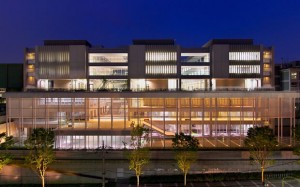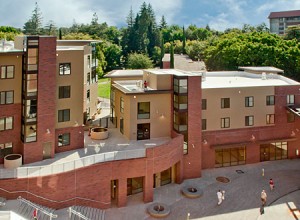Annoucement (Oct. 20, 2014)
The article which is related to the blog entry below has been just published in “Building and Enviroment.”
Sheau-Chyng Wong and Naoya Abe, Stakeholders’ Perspectives of a Building Environmental Assessment Method: the Case of CASBEE, Building and Environment (2014), pp. 502-516, DOI information: 10.1016/j.buildenv.2014.09.007
******************
– By S. Wong, M2 student
The upcoming spring semester will be an exciting and important semester for me. My big goal for the semester is to complete my master’s research project, which aims to study the adoption and diffusion of CASBEE in the Japanese building market. In particular, this study examines the issue from the perspectives of the project stakeholders of CASBEE.
Comprehensive Assessment System for Built Environment Efficiency (CASBEE) is a green building rating system developed and widely used in Japan. Although CASBEE is well-known and respected amongst the international green building community, its practical application has been limited in Japan. Language barrier appears to be the primary reason; most CASBEE standards and tools are only available in Japanese.
My interest in CASBEE stems from my professional experience as a mechanical engineer and LEED accredited professional in California before enrolling in Tokyo Tech. The LEED (Leadership in Energy and Environmental Design) assessment system, developed by the US Green Building Council (USGBC), is the most widely adopted green building standard in the current U.S. market. Since the release of its pilot program (LEED 1.0) in 1998, LEED has been transformed into the “world’s biggest green-building brand name” due to the successful marketing efforts by USGBC.
During my first semester, in search of a research topic, I started reading and learning about CASBEE. At first glance, CASBEE appears to be the “Japanese equivalent of LEED”. As I delved more into this subject, I realized the differences between CASBEE and LEED are more than just the language. CASBEE is fundamentally an ‘architectural’ design tool, but LEED standards comprise or could be dissected into various architectural and engineering elements. CASBEE is most commonly utilized as a ‘checklist for sustainable design, and an official CASBEE certification is rarely pursued [1]; LEED certification is customarily pursued by project owners for marketing and promotional purposes and LEED certified buildings are growing every day [2] . The other impression I get is that many evaluation items in CASBEE are subjective and are not as clearly defined compared to LEED. While I endorse the holistic approach of CASBEE, which looks to evaluate the interactions between a building and its surrounding, I wonder if some wordings in the standards are too academic to comprehend and the measures too difficult to quantify.
On a different note, I wonder how my peers – architects, engineers, contractors etc. – in Japan ‘feel’ about CASBEE and how motivated are they in the application CASBEE in their daily work. Even though some companies have adopted CASBEE as their in-house design standards [3] , are their staffs enjoying working with the CASBEE tools, or are they simply following directive from the management? Are the tools truly effective in terms of time, cost and practicality, or could it just be a greenwashing campaign when a company claims CASBEE adoption as part of their green practice? I had the same questions about LEED and other green standards while I myself was immersed in the ‘green building industry’ in the US. I had encountered people who were truly passionate about green buildings and eco-design; I also had friends in the business who did not believe in global warming and sustainable design, yet unabashed about putting LEED accreditation on their resume for the sole purpose of marketing. Newer generations appear more enthusiastic about sustainable building and the role of LEED in that subject; older generations prefer conventional practices and are more risk averse when it comes to new technologies and changes.
In Japan, a sustainable building is often defined as one that is designed “to save energy and resources, recycle materials and minimize the emission of toxic substances throughout its life cycle, to harmonize with the local climate, traditions, culture and the surrounding environment, and to be able to sustain and improve the quality of human life while maintaining the capacity of the ecosystem at the local and global levels” [4]. While the emphasis on energy, resources and recycling are commonly the focus subjects in sustainable building, which is obvious within the LEED guidelines, the concept of harmoniz[ing] with the local climate, traditions, culture and the surrounding environment is somewhat unfamiliar to the American culture. My experience in living in California tells me that, for the people in that region, comfort comes first when it comes to the living environment but the meaning of comfort varies by individuals; it could mean big yard for their children, central air conditioning for personal well-being, prime location in a city for access convenience, or anything that bring them contentment. This understanding of the differences between two cultures makes me wonder: is there a fundamental attitude differences towards sustainable building between the building professionals in the two countries? Across the Pacific Ocean, do people think alike, or differently? With any luck, I will get some answers upon the completion of my research.

CASBEE rank S
Source:http://www.city.yokohama.lg.jp/kenchiku/center/kankyo/casbee

LEED Gold Award
Source: http://www.csuchico.edu/maps/campus/sutter.shtml
[1] Number of certified buildings is 196 as of February 28, 2013: http://www.ibec.or.jp/CASBEE/index.htm
[2] Number of certified buildings is over 13,000 as of March 20, 2013: http://www.gbci.org/
[3] Imai, Y., Kajimoto, K., Miura, T., & Hirate, K. (2011). Study on Promotion of Design for Environment in Design Divisions within Large General Contractors in Japan. SB11 Helsinki World Sustainable Building Conference.
[4] Architectural Institute of Japan (AIJ). (2005). Architecture for a Sustainable Future – All About the Holistic Approach in Japan. Institute for Building Environmental and Energy Conservation (IBEC).